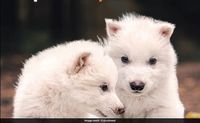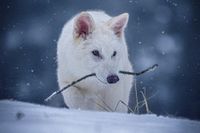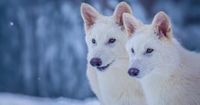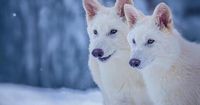In a groundbreaking announcement, Colossal Biosciences, a Texas-based biotechnology firm, has claimed to have resurrected the once-extinct dire wolf, a species that vanished from the Earth over 12,500 years ago. On April 7, 2025, the company unveiled that it had successfully birthed three dire wolf pups, two males named Romulus and Remus, and a female named Khaleesi, in a move that has sparked excitement and skepticism across the scientific community.
Colossal Biosciences, which describes itself as the "world’s only de-extinction company," utilized advanced genetic engineering techniques to bring these ancient creatures back to life. The process involved extracting DNA from two fossilized remains—a 13,000-year-old tooth and a 72,000-year-old skull—and making 20 targeted edits to the genetic code of a grey wolf, its closest living relative. This method mirrors the fictional techniques depicted in the movie Jurassic Park, where scientists use DNA from modern relatives to recreate extinct species.
CEO Ben Lamm expressed pride in the achievement, stating, "This massive milestone is the first of many coming examples demonstrating that our end-to-end de-extinction technology stack works. Our team took DNA from a 13,000-year-old tooth and a 72,000-year-old skull and made healthy dire wolf puppies. It was once said, ‘any sufficiently advanced technology is indistinguishable from magic.’ Today, our team gets to unveil some of the magic they are working on and its broader impact on conservation.”
The dire wolf has been popularized in modern culture, particularly through the HBO series Game of Thrones, where characters are often depicted with dire wolf companions. George R. R. Martin, the creator of the series, is not only an investor in Colossal but also serves as a cultural adviser, further intertwining the company’s scientific endeavors with pop culture. Martin remarked, "Many people view dire wolves as mythical creatures that only exist in a fantasy world, but in reality, they have a rich history of contributing to the American ecosystem.”
However, the claim of successfully de-extincting the dire wolf has not gone without scrutiny. Some scientists are questioning the validity of Colossal's assertions, suggesting that what has been created are genetically modified grey wolves rather than true dire wolves. Emily Roycroft from Monash University's Evolutionary and Conservation Genomics Research Group pointed out that while the pups may exhibit some traits reminiscent of dire wolves, they are essentially grey wolves with edited genomes. "Editing a few genes of the grey wolf does not make a dire wolf," she explained. "There are many other factors that make dire wolves unique, including an entire suite of genetic, epigenetic, and behavioral differences that we don't currently understand.”
Critics like Professor Nic Rawlence from the Otago Palaeogenetics Laboratory echoed these sentiments, stating, "What Colossal Biosciences have produced is a grey wolf with dire wolf-like characteristics. This is not a de-extincted dire wolf; rather, it's a hybrid.”
Despite the skepticism, Colossal maintains that their creations embody the key morphological traits, behavioral characteristics, and ecological functions that defined the species. The company has referred to the pups as “functionally de-extincted,” a term it defines as the creation of organisms that resemble and are genetically similar to extinct species, with engineered traits to help them thrive in the modern world. This has led to a lively debate in the scientific community regarding the definition of de-extinction and whether it can be achieved through genetic modification of existing species.
The dire wolf pups are currently being raised in a secure ecological preserve that spans over 2,000 acres, equipped with 10-foot-tall fencing and monitored through live cameras and drones to ensure their safety and well-being. The preserve also includes facilities for veterinary care and wolf management, providing a controlled environment for the pups as they grow.
Colossal has ambitious plans beyond just the dire wolf. The company has previously announced efforts to revive other extinct species, such as the woolly mammoth and the dodo bird, and is currently working on a genetically engineered rodent known as the "Colossal woolly mouse," which possesses key traits of the mammoth. This research aims to validate the de-extinction process before moving on to larger and more complex animals.
While the excitement surrounding the dire wolf’s revival captures public imagination, it also highlights the ethical and ecological implications of such scientific endeavors. The potential to bring back extinct species raises questions about biodiversity, ecosystem balance, and the responsibilities of humans as stewards of the planet. MHA Nation Tribal Chairman Mark Fox commented on the cultural significance of the dire wolf’s return, stating, "The de-extinction of the dire wolf is more than a biological revival. Its birth symbolizes a reawakening – a return of an ancient spirit to the world. The work of the team at Colossal Biosciences is not only significant to our lands and people but for conservation efforts across the globe.”
As Colossal Biosciences continues to navigate the complexities of de-extinction, the world watches closely, eager to see how these scientific advancements will unfold. The journey of Romulus, Remus, and Khaleesi may just be the beginning of a new era in conservation and genetic engineering, but the path ahead is fraught with challenges and questions that remain to be answered.








